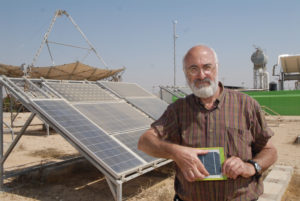
Israel’s Solar Future
July 10, 2020
By Prof. Emeritus David Faiman, of BGU’s Alexandre Yersin Department of Solar Energy and Environmental Physics, and the first director of Israel’s Ben-Gurion National Solar Energy Center
The Jerusalem Post — On a large plot of barren desert adjacent to Moshav Ashalim, a remarkable, long-term experiment is unfolding.
Three independent consortia, each employing a different kind of solar technology, are learning how to operate their giant power plants as effectively as possible under the constantly changing weather conditions.
Contrary to the negative economic image that some people have rushed to give the Ashalim solar project, it is an experiment that, like our country’s attempt to land on the moon, should be hailed as a major Israeli achievement and contribution to humankind.
When I give tours as professor emeritus of Ben-Gurion University of the Negev, I usually explain to nonexperts the advantages and shortcomings of each, and the unique importance of having all three solar technologies operating at the same place in the Negev.
Because no single conventional power-generating technology is capable of providing power 24 hours everyday, while doing so as economically as possible, the Israel Electric Corporation uses a combination of coal-burning, gas-burning and oil-burning plants.
Each technology on its own has very different economics in terms of plant cost, maintenance costs and fuel costs.
The reason they do not use only coal is because to do so would involve the company having to generate huge amounts of power during times when there are no customers to use it, because coal plants respond very slowly to changing needs.
The most cost-effective strategy is accordingly to use the company’s different power plant types, fired up and ramped down according to a computer algorithm that constantly measures customer needs, taking into account varying fuel costs, and the age and maintenance costs of all plants.
With these constraints in mind, here’s what solar power could do for Israel in the future, not the least of which is that the goal of pollution-free power-production is worth reaching.
Seemingly, the “cheapest” solar technology is an array of photovoltaic panels.
Such a power plant is certainly the simplest to build and panel prices have dropped drastically in the last few years owing to competition among manufacturers for the enormous markets this versatile technology has created (e.g. wrist watches, parking meters, bus-stop schedules, roof-top arrays, and all the way up to multi-megawatt power plants).
But photovoltaic power plants have panels that produce power instantaneously, in quantities that follow the momentary variations in solar illumination.
This means that their output cannot, as yet, be controlled.
By contrast, solar-thermal technology has the important advantage that instead of generating electricity directly, it generates thermal energy (i.e., heat) as an intermediate step.
Unlike electricity, thermal energy is easy to store. This enables the electricity to be generated at a more desirable time of day according to needs.
Consequently, the data that will emerge when all three systems that feed the power grid will enable future electricity planners to develop an appropriate algorithm for operating the three, under all weather conditions, in much the same way that coal, gas and oil plants are shuttled on and off today.
With appropriate storage, approximately 90% of Israel’s future electricity needs could be provided by photovoltaic panels, with the remaining ten percent being provided by gas backup – mainly for sequences of cloudy days in winter.
When the results of the Ashalim experiment are digested, it is not inconceivable that solar-thermal plants, together with some wind turbines might someday complement photovoltaic plants and render Israel’s electricity generation 100% independent of fossil fuels.
So, it is not inconceivable that one day, gigawatt-size solar power plants, each covering some 16 sq.km. and dotting the vast Sinai and Jordanian deserts, could provide copious electrical power for all three nations, and also for the Palestinians.
The West Bank could receive its power from Jordan while the Gaza Strip could receive its power from Egypt. Perhaps with enough electricity to allow full economic development, a future Palestinian administration would consider afresh the advantages of living in peace with Israel.




